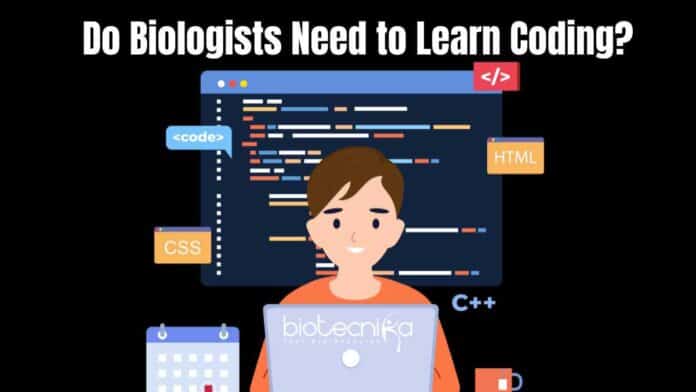Biology, the science of life, has made incredible strides in recent decades, largely thanks to the integration of computational methods and technology. The relationship between biology and coding has become increasingly intertwined, leading to the question: Do biologists need coding skills? In this article, we will explore the importance of coding in modern biology, the specific applications of coding in this field, and the benefits it brings to researchers and scientists.
Table of Contents
The Intersection of Biology and Coding: A Detailed Exploration
In recent years, the field of biology has undergone a profound transformation, moving beyond traditional laboratory experiments and embracing computational techniques as an integral part of research and discovery. This transformation is driven by the explosion of biological data generated through various ‘omics’ approaches, such as genomics, proteomics, transcriptomics, and metabolomics. Coding skills have become increasingly crucial for biologists, enabling them
to harness the power of data analysis, modeling, and automation in their research. Let’s delve deeper into these aspects:-
Data Analysis and Interpretation:
- Vast Datasets: Biologists now have access to immense datasets, such as genomic sequences, gene expression profiles, and protein-protein interaction networks. These datasets are often too large and complex for manual analysis.
- Coding’s Role: Coding languages like Python and R are commonly used to process, manipulate, and analyze biological data efficiently. Biologists can write scripts to extract relevant information, perform statistical analyses, and identify patterns hidden within the data.
- Biological Insights: Through coding, researchers can uncover valuable insights, such as identifying disease-related genetic mutations, tracking evolutionary relationships, or understanding how genes are regulated.
Get started with Coding from Basics, beginners coding course for biologists – register now
- Python Basics Certification Course
- Computer Aided Drug Design (CADD) Certification Course
- MATLAB Training Course With Demo Sessions For Beginners
- R Programming Language Certification Course
2. Modeling and Simulation:
- Complex Biological Processes: Many biological phenomena, such as ecosystem dynamics, cellular processes, and protein folding, are inherently complex and challenging to study through traditional experiments alone.
- Coding’s Role: Computational models and simulations enable biologists to create simplified representations of these processes. By coding mathematical equations and rules, scientists can simulate these processes, experiment with different parameters, and better understand how they work.
- Applications: Computational models have been used to study population dynamics, the spread of infectious diseases, the impact of climate change on ecosystems, and the behavior of biomolecules. These models help predict outcomes and guide experimental design.
3. Data Visualization:
- Effective Communication: Visualizations are essential for conveying complex biological findings to diverse audiences, including fellow researchers, clinicians, policymakers, and the general public.
- Coding’s Role: Coding allows biologists to create customized data visualizations. Tools and libraries in languages like D3.js, Matplotlib, and ggplot2 enable the creation of interactive charts, heatmaps, phylogenetic trees, and 3D models. This enhances the clarity and accessibility of research results.
- Outreach: Visualizations can be used in scientific publications, presentations, and educational materials to engage and inform a broader audience.
4. Automation:
- Repetitive Tasks: Biological research often involves repetitive and time-consuming tasks, such as data cleaning, image analysis, and data integration.
- Coding’s Role: Biologists can write scripts and programs to automate these tasks. This saves time and reduces the likelihood of errors that can arise from manual work. Automation frees researchers to focus on more creative and analytical aspects of their work, accelerating the pace of discovery.
5. Machine Learning and Artificial Intelligence:
- Biological Predictions: Machine learning and AI techniques have revolutionized biology by enabling the prediction of biological outcomes, drug discovery, and the identification of genetic markers associated with diseases.
- Coding’s Role: Biologists with coding skills can implement and fine-tune machine learning algorithms to analyze biological data. This includes training models for image recognition, predicting protein structures, identifying biomarkers in patient data, and even automating the analysis of high-throughput screening assays.
6. Bioinformatics:
- Specialized Field: Bioinformatics is a specialized field that sits squarely at the intersection of biology and computer science.
- Coding’s Role: Bioinformaticians use coding to tackle a wide range of biological challenges. They develop algorithms for sequence alignment, predict protein structures, conduct comparative genomics to identify evolutionary relationships, and create databases to store and retrieve biological information. Coding expertise is fundamental to the success of bioinformatics research and applications.
In summary , the integration of biology and coding has become inseparable in contemporary biological research. Coding skills empower biologists to efficiently analyze vast datasets, construct models, visualize complex data, automate tedious tasks, leverage machine learning, and excel in the specialized domain of bioinformatics. As the volume and complexity of biological data continue to grow, proficiency in coding will remain a cornerstone of modern biological inquiry, enabling researchers to unravel the mysteries of life with unprecedented depth and precision.
Applications of Coding in Biology
Let’s delve deeper into some specific applications where coding is indispensable for biologists:
-
Genome Sequencing and Annotation:
- Genome Assembly: Genome sequencing generates massive amounts of DNA data that must be assembled into complete genomes. Coding is used to develop algorithms and software for this purpose. Popular tools like Velvet and SOAPdenovo utilize coding to piece together DNA fragments into cohesive genomes.
- Gene Identification: Biologists need to identify genes and their functions once a genome is assembled. Coding plays a vital role in developing gene prediction algorithms. Tools like GeneMark and AUGUSTUS use coding to recognize open reading frames (ORFs) and predict gene structures.
- Functional Annotation: Understanding the function of genes is crucial. Coding is used to create databases and tools that match gene sequences with known functions, enabling researchers to annotate genes based on homology. BLAST (Basic Local Alignment Search Tool) is a prime example.
2. Phylogenetics:
- Phylogenetic Tree Construction: Phylogenetics involves studying the evolutionary relationships among species by comparing DNA or protein sequences. Coding is used to implement algorithms like neighbor-joining and maximum likelihood to build phylogenetic trees. Software packages such as RAxML and PhyML leverage coding for these analyses.
- Sequence Alignment: Coding is essential for aligning DNA or protein sequences to identify similarities and differences. Multiple sequence alignment programs like ClustalW and MAFFT use coding to optimize alignments, aiding in phylogenetic analyses.
3. Structural Biology:
- Protein Structure Prediction: Predicting the 3D structure of proteins is crucial for understanding their functions and designing drugs. Software like Rosetta employs complex coding algorithms to predict protein structures based on principles of physics and chemistry.
- Molecular Visualization: Coding is used to create sophisticated molecular visualization software like PyMOL and ChimeraX. These tools allow researchers to visualize protein structures and analyze molecular interactions, aiding in drug design and structural biology research.
4. Ecological Modeling:
- Population Dynamics: Ecological models, such as those used to study predator-prey interactions or population growth, rely on coding to simulate complex ecological systems. Researchers write code to represent the rules governing species interactions and environmental factors.
- Climate Change Impact: Coding is indispensable for building climate models that predict how ecosystems and species may respond to environmental changes. These models help ecologists understand and mitigate the impacts of climate change on biodiversity.
5. Drug Discovery:
- Molecular Docking: Coding is used to create molecular docking algorithms that simulate how potential drug molecules interact with target proteins. These simulations predict the binding affinity and interactions between drug candidates and their target proteins.
- Virtual Screening: Coding facilitates high-throughput virtual screening of chemical libraries against target proteins. This process identifies potential drug candidates by evaluating their ability to bind to a target, saving time and resources in the drug discovery pipeline.
- Quantitative Structure-Activity Relationship (QSAR): QSAR models, which correlate the chemical structure of compounds with their biological activity, are developed using coding. These models help predict the biological activity of new compounds, guiding drug discovery efforts.
In summary, coding is an indispensable tool in various areas of biology, enabling scientists to tackle complex biological questions and accelerate research. It plays a crucial role in genome analysis, phylogenetics, structural biology, ecological modeling, and drug discovery, empowering biologists to make significant advancements in their respective fields. As technology continues to advance, coding will remain a driving force in the ever-evolving intersection of biology and computational science.
Benefits of Coding for Biologists
Biologists who acquire coding skills stand to gain several advantages:
-
Independence:
- Problem Solving: Coding equips biologists with problem-solving tools, allowing them to address complex research questions independently. They can develop custom scripts and algorithms tailored to their specific biological experiments or data analysis needs.
- Data Analysis: Biologists can use coding skills to analyze and visualize large datasets without relying solely on bioinformatics or data analysis experts. This independence enables them to extract meaningful insights from their data promptly.
2. Efficiency:
- Streamlined Data Analysis: Coding enables biologists to automate data processing and analysis tasks. This saves time and reduces the potential for errors associated with manual data handling.
- Experimental Design: Biologists can use coding to design experiments with greater precision. For instance, they can create scripts to control laboratory equipment, collect data, and adjust experimental parameters in real-time, enhancing the efficiency and reproducibility of experiments.
- Rapid Prototyping: Biologists can use coding to create prototypes quickly when developing new research methods or protocols. This allows them to test ideas and refine their approaches iteratively.
3. Interdisciplinary Collaboration:
- Cross-Disciplinary Work: Coding skills facilitate effective collaboration with researchers from other disciplines, such as computer science, statistics, and engineering. Biologists can bridge the biology and computational science gap, fostering interdisciplinary research projects.
- Common Language: Coding is a common language between biologists and computational experts. This enhances communication and collaboration, ensuring that both parties’ expertise contributes to a project’s success.
4.Career Opportunities:
- Academia: In academia, coding proficiency is increasingly valued and expected in various biological subfields. Researchers who can independently develop and implement computational methods often have a competitive advantage in securing grants and publishing high-impact research.
- Industry: Many biotechnology, pharmaceutical, and healthcare companies require biologists with coding skills for roles in drug discovery, genomics, bioinformatics, and data analysis. Coding expertise enhances a biologist’s employability and potential for advancement in industry settings.
- Government and Research Institutions: Government agencies and research institutions also seek biologists who can harness computational tools for tasks like data analysis, modeling, and policy analysis. Coding skills are an asset in securing positions in these sectors.
5. Innovation:
Custom Solutions: Biologists with coding skills can innovate by developing custom software or tools tailored to their unique research needs. This flexibility allows them to explore novel avenues of investigation and make groundbreaking discoveries.
Adaptation to Emerging Technologies: As new technologies and data analysis methods emerge in biology, coders can quickly adapt and integrate these advances into their research, staying at the forefront of their fields.
Biologists benefit significantly from coding skills in today’s data-driven and technology-driven world. The ability to analyze data, build models, and automate processes has become essential for advancing biological research. Whether you are a molecular biologist, ecologist, or geneticist, coding skills open up new possibilities, enhance research outcomes, and broaden career prospects. The symbiotic relationship between biology and coding is here to stay, and biologists who embrace it will continue pushing scientific discovery’s boundaries.







































